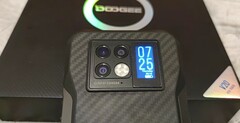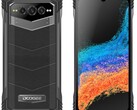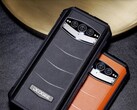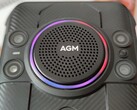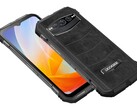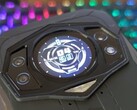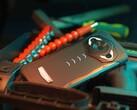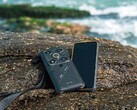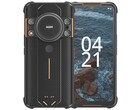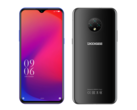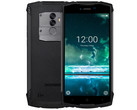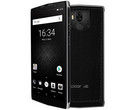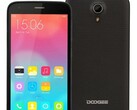Established in Spain back in 2013, Doogee is now headquartered in Shenzhen, China's famous tech hub. In 2016, the company had managed to sell more than 15 million handsets. Now, this brand is present in no less than 160 countries and delivers affordable smartphones, smartwatches, as well as rugged smartphones with innovative features such as night vision cameras, laser rangefinders, or infrared thermometers.
Today, we will take a closer look at the Doogee V20, a rugged Android 11 handset that uses the MediaTek Dimensity 700 chipset, thus bringing together military-grade protection and a set of features ideal for a daily driver, such as 5G connectivity, NFC support, a generous battery, a bright AMOLED display, and more.
While rugged phones usually target a rather limited audience, the performance of the aforementioned chipset in most mainstream games — combined with the device's resilience and the generous amount of memory and onboard storage — could make the Doogee V20 a worthy choice for kids and teenagers who usually break two or three regular smartphones in a year. With a price tag of US$399.99 (down from US$499.99), this handset is not one of the cheaper Dimensity 700-driven ones out there, so today we will see if it packs a punch strong enough to be relevant for more than just a few enthusiasts.
Box contents, design, build quality
The Doogee V20 comes inside a square and thin cardboard box covered on all sides with a stylish texture, which is also pleasant to the touch. While most buyers don't pay much attention to this part, I must highlight the fact that this is one of the best-looking retail boxes that I've seen so far (when talking about phones, of course).
Inside the aforementioned box, Doogee is offering a rich set of accessories alongside the phone. In addition to the V20, the retail package contains a SIM extractor tool, a USB-C to USB-C cable, a USB-A to USB-C adapter, a 33 W power adapter, a screen protector (in addition to the one already installed) alongside a pair of wipes to use when applying it, a user manual (a few pages of basic information provided in no less than 13 languages), as well as a warranty card. The protective case/bag, USB stick, and baseball cap shown in the pictures above are not part of the standard retail package, unfortunately, and cannot be purchased separately.
Design-wise, the Doogee V20 is a "take it or leave it" handset because there aren't any skins/cases that can be used to customize it, so the potential buyer should like one of the available colors. Although there are no blue or green variants, the Knight Black and Wine Red (both with a carbon fiber texture on the back) models look great, and so does the stylish Phantom Gray variant. After all, this is not a phone to buy for its looks, but — as far as my taste goes — the Doogee V20 is far from ugly.
The bezels of this handset are noticeable, to say the least, but this is one of the trade-offs needed to deliver a rugged device. Although the size of the display is 6.43 inches, the phone is slightly bigger than my old Mi 10T Pro, which has a 6.67-inch display. Unsurprisingly, the Doogee V20 is also thicker and heavier than my phone.
The buttons feel solid and the use of a customizable button on the left side is a great idea. The SIM tray (hybrid dual SIM) is also located on the left. There are no ports or buttons on top. The speaker is located at the bottom, to the right of the USB-C charging port, which is protected by a protective cover that keeps water and dust at bay. The fingerprint scanner is placed on the power button, which is located on the right side. Lastly, the camera assembly shares a distinct area on the back of the phone with the innovative rear display, a feature that can be quite handy in many scenarios.
The materials used look and feel great, but there is a tiny problem with the build approach. Although I can't call this a problem, it is obvious the case that surrounds the phone's inner components was glued, and not molded. The metallic sides are set in place using screws, but the top and bottom polycarbonate parts have been glued onto the frame. The craftsmanship is not perfect, but it's pretty good nevertheless. Sadly, even two or three months of intense testing cannot show if this build can last for two years or more when subjected to temperature changes and physical trauma. However, the fact that the Doogee V20 is certified to comply with the IP68, IP69K, and MIL-STD-810G standards should say enough about its ability to tackle various hazards.
Specs, features, real-life usage
The Doogee V20 arrived shortly after the release of the V10, which uses the same chipset but has a slightly smaller display (and a less power-efficient one that uses the LCD technology), less storage, and less capable cameras. The V20 is available with 8 GB of memory and 256 GB of UFS 2.2 storage, which can be supplemented with the help of a microSD card. The punch-hole 6.43-inch AMOLED display has a pixel density of 409 PPI, as it sports a resolution of 1080 X 2400 pixels. The screen has a typical brightness of 500 cd/m2 and 80,000:1 contrast and is protected using Corning Gorilla Glass 5 (below the screen protector applied on top, of course). Sadly, the refresh rate is only 60 Hz. Performance-wise, everything meets the expectations one would have from a handset driven by the MediaTek Dimensity 700 chipset.
The 16 MP front camera uses a Samsung-made sensor, and the triple camera on the back (64 + 20 + 8 MP) includes a 20 MP night shooter that uses the Sony IMX350. The main camera can shoot videos up to 2K in resolution, but the results are not impressive. Since stabilization is not available, shooting video content while in motion leads to jiggly results. However, using apps that provide software-assisted stabilization can get the job done in some cases (OpenCamera, for example).
With a weight of 296 grams (0.65 pounds), the Doogee V20 measures 170.5 X 81.2 X 14 mm (6.71 X 3.19 X 0.55 in). These dimensions might seem gargantuan for some users, but contemporary flagships can get even bigger when tucked inside a rugged watertight case that provides all-around protection.
In addition to the aforementioned night shooter, which failed to impress me much (see a few shots at the end of this section), the most interesting feature of the Doogee V20 is the 1.05-inch rear display. Thanks to it, the user can start playing music, reply or cancel calls, and check the time and date, as well as the current battery level. For now, there are only a few presets available, but I hope to see more visual themes for this secondary display.
When running GeekBench 5.4.4, I got a single-core score of 513 and 1,668 multi-core points. The results of the Compute tests were 1,427 (Vulkan) and 1,423 (OpenCL). The internal storage, according to A1 SD Bench, is capable of over 600 MB/s when writing data, and reads of roughly 210 MB/s. The same benchmark measured a memory speed of over 25,000 MB/s.
Benchmarks aside, I can say that I tried most apps and games that I usually run on my Xiaomi Mi 10T Pro and there is no noticeable lag, if I leave aside the screen refresh advantage in favor of the Mi 10T Pro which becomes obvious in titles like NFS No Limits or Asphalt 9. However, I should also point out that the brightness and viewing angles of V20's display are a major advantage when using the handset in direct sunlight.
While the bottom speaker is decent and loud enough, the lack of stereo sound is a shame when using the handset to watch videos or to play games. On the other hand, the earpiece is surprisingly loud, especially given the fact that waterproof phones often provide a rather muffled earpiece sound, due to the speaker protection used. The signal strength is very close to what I get on the Mi 10T Pro on the same network (measured using WiFiman), but I wasn't able to get 5G signal on any of them (extremely poor 5G signal in the city, not a problem with the phones).
Given its capacity, combined with the display and chipset used, battery life is unsurprisingly excellent, with at least two days of mixed use that includes gaming, phone talks, as well as photo and video shooting. In this case, wireless charging is a welcome addition to the list of features, because it helps the user to avoid removing the protective cover of the USB-C port. In time, the wear and tear caused by repeating this operation could affect the waterproofness of the device. Lastly, Doogee says that the battery should still be able to hold more than 80 percent of its nominal capacity after 500 charge cycles, so the V20 should still feel fresh from this point of view after three years of regular use.
Software highlights
The software that comes installed on the Doogee V20 is, basically, stock Android 11, but there are some custom touches here and there. The list of such touches includes the DuraSpeed app booster (disabled by default and also available for devices with MediaTek chipsets from other brands), the pieces of code needed to customize the rear display and the programmable button, as well as the OutDoor Toolbox app suite. This "virtual toolbag" includes a bunch of tools that can be handy in certain work- or travel-related situations. The list includes a compass, a gradienter, a height measuring tool, a decibel meter, a magnifier, and a few others.
While using the phone, I never faced any system crashes, random restarts, or app freezes. The software experience is excellent and highly customizable, just as expected. Speaking of custom touches, I should mention the underwater mode of the camera software, which allows the user to operate the camera with the help of the physical buttons alone.
Although there is no date to talk about yet, Doogee has confirmed that this handset will get updated to Android 12. For the time being, this is certainly a strong selling point of the Doogee V20. It is great to see that the company pays attention to the after-sales software support side of the business, unlike many other small brands.
The good, the bad, and the truth
The Doogee V20 is faster than many of the rugged phones out there, has a bright display with a generous resolution, it sports 5G connectivity and NFC, a 6,000 mAh battery with 33 W wired and 15 W wireless charging, near-stock Android 11 with regular updates (at least Android 12 will come to it), a fast fingerprint scanner, and even most modern games run well on it. The generous amount of storage space should be enough for most users, and same thing goes for the 8 GB of memory.
Although it is built like a tank, the Doogee V20 can be a bit rough around the edges. The pre-applied protective glass, for example, will impact the ground directly if the phone falls facing down. Many protective cases for regular handsets simply have their edges facing up a bit longer, so falls facing down on concrete are almost safe, since the screen doesn't touch the ground. There is no 3.5 mm jack present and, since the camera assembly doesn't allow the phone to sit perfectly on its back, using the gradienter can get tricky. Lastly, the cameras should (and could) deliver better stills and videos, and — hopefully — something can be done about it in a future software update.
While it is not perfect, the Doogee V20 has a lot going for it. If not for the night vision camera or the precise craftsmanship, this rugged phone is worth its price for the overall performance and excellent battery life, as well as the software environment. Not a device for kids or people with small hands, but definitely one for those who like their digital companions built to last.
Disclaimer: The author of this review received the Doogee V20 rugged smartphone from Doogee free of charge for the purpose of testing.
Source(s)
Doogee (official product page)


 Deutsch
Deutsch English
English Español
Español Français
Français Italiano
Italiano Nederlands
Nederlands Polski
Polski Português
Português Русский
Русский Türkçe
Türkçe Svenska
Svenska Chinese
Chinese Magyar
Magyar